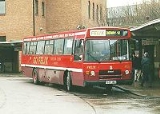
Plaxton Derwent 3000
Encyclopedia
The Plaxton Derwent 3000 was a bus
body
built by Plaxton
. It was introduced in 1986, and is not related to the earlier Plaxton Derwent body which was built between 1962 and 1977.
Around 250 were built, almost four times as many as its predecessor, the Plaxton Bustler, over a similar number of years.
It was built mainly on mid-engined chassis, although a small number of Scania K93 rear-engined chassis were also bodied. The most common chassis was the Leyland Tiger
, largely due to orders from the UK military
for over a hundred, some of which were left-hand drive
. Other chassis were the Volvo B10M
(including short wheelbase
examples); some of the last Bedford
Y-Series to enter service; Dennis Javelin
; and around fifteen secondhand Leyland Leopard
chassis being rebodied.
The Derwent 3000 was superseded by the Plaxton Verde
from 1991.
In the post-1989 system, the letters E and F identified the Derwent.
3200, 3500 and 4000).
The model was initially launched as the Derwent II, even though the numeral II had already been used for the previous Derwent model between 1966 and 1977.
Bus
A bus is a road vehicle designed to carry passengers. Buses can have a capacity as high as 300 passengers. The most common type of bus is the single-decker bus, with larger loads carried by double-decker buses and articulated buses, and smaller loads carried by midibuses and minibuses; coaches are...
body
Coachwork
Coachwork is the body of a horse-drawn coach or carriage, a motor vehicle , a railroad car or railway carriage. Usually reserved for bodies built on a separate chassis, rather than being of unitary or monocoque construction...
built by Plaxton
Plaxton
Plaxton is a builder of bus and coach vehicle bodies based in Scarborough, England.-History:The Plaxton of today is the successor to a business founded in Scarborough in 1907 by Frederick William Plaxton.-Beginnings:...
. It was introduced in 1986, and is not related to the earlier Plaxton Derwent body which was built between 1962 and 1977.
Around 250 were built, almost four times as many as its predecessor, the Plaxton Bustler, over a similar number of years.
It was built mainly on mid-engined chassis, although a small number of Scania K93 rear-engined chassis were also bodied. The most common chassis was the Leyland Tiger
Leyland Tiger
The Leyland Tiger, also known as the B43, was a mid-engined bus and coach chassis which was built between 1981 and 1993. This name had previously been used for a front-engined bus built between 1920s and 1950s. It replaced the Leyland Leopard, which had been in production for over 20 years...
, largely due to orders from the UK military
Ministry of Defence (United Kingdom)
The Ministry of Defence is the United Kingdom government department responsible for implementation of government defence policy and is the headquarters of the British Armed Forces....
for over a hundred, some of which were left-hand drive
Driving on the left or right
The terms right-hand traffic and left-hand traffic refer to regulations requiring all bidirectional traffic to keep either to the right or the left side of the road, respectively. This is so fundamental to traffic flow that it is sometimes referred to as the rule of the road. This basic rule eases...
. Other chassis were the Volvo B10M
Volvo B10M
The Volvo B10M is a popular mid-engined bus and coach chassis built by Volvo between 1978 and 2001. It was built as the successor of the B58 and was equipped with a 9.6-litre horizontally-mounted Volvo THD100/THD101/THD102/THD103/THD104/DH10A diesel engine mounted under the floor, near the middle...
(including short wheelbase
Wheelbase
In both road and rail vehicles, the wheelbase is the distance between the centers of the front and rear wheels.- Road :In automobiles, the wheelbase is the horizontal distance between the center of the front wheel and the center of the rear wheel...
examples); some of the last Bedford
Bedford Vehicles
Bedford Vehicles, usually shortened to just Bedford, was a subsidiary of Vauxhall Motors, itself the British subsidiary of General Motors , established in 1930; and constructing commercial vehicles. Bedford Vehicles was a leading international truck manufacturer, with substantial export sales of...
Y-Series to enter service; Dennis Javelin
Dennis Javelin
The Dennis Javelin is an underfloor-engined bus and coach chassis originally built by Dennis in the United Kingdom. It was unveiled in 1986 and acted more or less as a modern replacement for the discontinued Bedford Y-series...
; and around fifteen secondhand Leyland Leopard
Leyland Leopard
The Leyland Leopard was a mid-engined single-deck bus and coach chassis built by Leyland between 1959 and 1982. It was popular with bus and coach operators throughout the British Isles...
chassis being rebodied.
The Derwent 3000 was superseded by the Plaxton Verde
Plaxton Verde
The Plaxton Verde was a single-decker bus body built by Plaxton between 1991 and 1997. It was built on rear-engined chassis, the most popular of which was the Dennis Lance which accounted for over half of the Verdes built. The rest were on Volvo B10B, DAF SB220 and Scania N113 chassis.The Verde has...
from 1991.
Body numbering
In the pre-1989 system of body numbers, the Derwent 3000 initially took the code D1B. This later became L2B, presumably to avoid confusion with the Paramount 4000, which also used the letter D. For military vehicles, MOD was used instead.In the post-1989 system, the letters E and F identified the Derwent.
Naming
The number 3000 in the model's name refers to its approximate height in millimetres (like the ParamountPlaxton Paramount
The Plaxton Paramount was a design of coach bodywork built by Plaxton. It first appeared at the 1982 British Motor Show and was built until 1991....
3200, 3500 and 4000).
The model was initially launched as the Derwent II, even though the numeral II had already been used for the previous Derwent model between 1966 and 1977.

